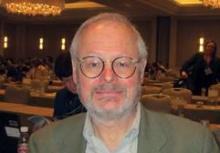SAN DIEGO – Is there a future for prostate cancer chemoprevention?
"Some people think not," Maarten C. Bosland, Ph.D., said during a conference sponsored by the American Association for Cancer Research and the Prostate Cancer Foundation. "Maybe we should just engage in more exercise and decrease our body weight."
Population studies of people who move from low-risk to high-risk countries indicate that the risk of prostate cancer – including the risk of dying from the disease – could be modified by environmental factors that are not yet understood. However, the 5-alpha reductase inhibitor trials provided proof of principle that the risk of a subset of prostate cancer can be reduced by drugs. Why, then, has the prostate cancer prevention field not moved forward?
Reasons for the current stagnation of progress include failure of the Selenium and Vitamin E Cancer Prevention Trial (SELECT) to show preventive activity of selenium and vitamin E; the failure of a high-risk phase III study to show preventive activity of selenized yeast; the refusal of the Food and Drug Administration to approve finasteride for prostate cancer prevention, and uncertainty regarding the long-term effects of treatment with 5-alpha reductase inhibitors, according to Dr. Bosland of the department of pathology at the University of Illinois at Chicago.
Then there’s the issue of clinical or biologic significance.
"Some prostate cancers start early while others start late," he explained. "In each of these categories, some of the cancers can lead to death and others won’t; they’ll remain clinically insignificant. This poses a problem in thinking about how to go about chemoprevention. We want to prevent death from prostate cancer, but the window of opportunity in which we can intervene in a chemoprevention setting is limited, and it encompasses different stages of prostate cancer. This is difficult in terms of how we conduct clinical trials and identify endpoints that are meaningful in terms of preventing death from prostate cancer."
In the case of SELECT, investigators made a direct jump to a phase III study, based on evidence from clinical trials with prostate cancer as a secondary endpoint. "I think we should go back to the traditional approach, with phase I, II, and III trials [of candidate agents for prostate cancer chemoprevention]," Dr. Bosland said.
"There were no phase II studies to support phase III trials when SELECT and other studies with selenium were started." Clinical study "needs to be driven by the biology and mechanisms of prostate cancer," he said.
Speaking in the context of clinical studies, Dr. Bosland said that researchers are challenged by the fact that prostate cancer development is complicated by a range of different pathways and multiple underlying mechanisms. "That is consistent with the enormous heterogeneity of prostate cancer morphologically, genetically, and clinically," he said. "There are several types of prostate cancer with a different frequency, time of onset, and potential to progress. This means that we need a broad spectrum of chemoprevention agents or combination of agents. Multiple preclinical models are needed to represent the different pathways/types of cancer and progression to lethality. We need to focus on the ultimate goal of preventing only aggressive lethal cancer. We don’t want to interfere with clinically insignificant cancer. It’s meaningless."
To accomplish this, Dr. Bosland recommended the development of a valid high-throughput system to identify new candidate agents for prostate cancer chemoprevention. "Markers of fatal/lethal disease need to be identified for application in clinical trials," he continued. "A systematic evaluation of the predictive value of preclinical models, phase II designs, and biomarkers is also needed."
His other recommendations include: Conduct no phase III trials before having data from phase II trials, and conduct no phase II trials before having adequate preclinical data; consider the mechanism and biology of the agent and target before embarking on clinical studies; and develop a rational identification of candidate agents based on biology, mechanism, and results of high-throughput screening. "Only if we do all of this and find the funding for it will there be a future for prostate cancer chemoprevention," Dr.Bosland concluded.
Dr. Bosland said he had no relevant financial conflicts to disclose.


